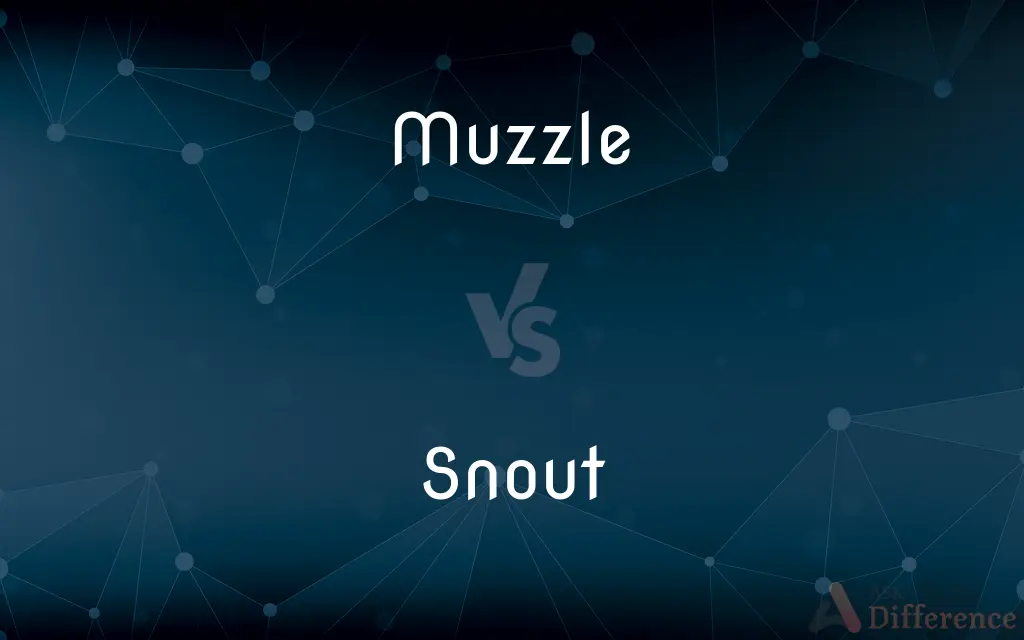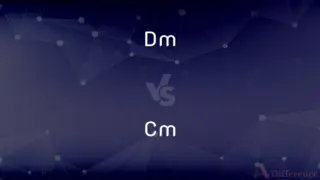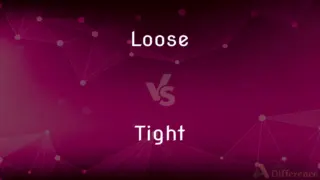Muzzle vs. Snout — What's the Difference?
Edited by Tayyaba Rehman — By Maham Liaqat — Updated on March 28, 2024
Muzzle refers to the projecting part of an animal's face, including the nose and mouth, often associated with restraint, while snout is the projecting nose and mouth of an animal, highlighting its shape and sensory function.

Difference Between Muzzle and Snout
Table of Contents
ADVERTISEMENT
Key Differences
Muzzle and snout both describe the front part of an animal's face, focusing on different aspects. The muzzle is often mentioned in contexts involving restraint or control, such as when dogs are required to wear a muzzle in public spaces for safety. This term emphasizes the part of the face that includes the nose and mouth, specifically in relation to its covering or restraint. On the other hand, the snout is more commonly used to describe the physical shape and function of an animal's nose and mouth area, often in a more neutral or descriptive sense. It highlights the sensory and feeding functions of this part of the face.
Muzzle is a term that also implies control or restriction, particularly in animals known to bite or bark, illustrating a concern for safety and discipline. Whereas, the snout is typically discussed in terms of its sensory capabilities, such as smelling or foraging, emphasizing the animal's interaction with its environment rather than control measures imposed on it.
In terms of usage, "muzzle" can denote both the physical part of the animal and the device used to cover it, illustrating a dual meaning that intertwines the anatomical aspect with a tool for restraint. Meanwhile, the term "snout" purely describes the anatomical feature, focusing on its natural form and function without the implication of control or modification.
When considering the variety of animals, the term "muzzle" is often used with domesticated animals, especially dogs, where there is a need to mention restraint devices. The snout, however, is used across a broader range of animals, including wildlife, highlighting the diversity in shape and function among different species.
Both terms, while referring to similar parts of an animal's anatomy, carry distinct connotations and uses, reflecting the nuances in human-animal relationships and the different focuses in animal anatomy and behavior.
ADVERTISEMENT
Comparison Chart
Definition
Part of an animal's face for breathing, eating, including a device for restraint
Projecting nose and mouth part of an animal, emphasizing shape and sensory function
Connotation
Often associated with restraint or control
Descriptive, focusing on natural form and function
Usage Context
Common in domestic animals, especially dogs
Broad, used for various animals including wildlife
Dual Meaning
Yes (anatomical part and restraining device)
No, purely anatomical
Focus
Safety, control, and discipline
Sensory capabilities and interaction with environment
Compare with Definitions
Muzzle
The nose and mouth part of an animal.
The dog's muzzle was gently holding onto the toy.
Snout
The projecting nose and mouth of an animal.
The pig dug into the ground with its snout.
Muzzle
A device placed over an animal's nose and mouth to prevent biting.
The vet put a muzzle on the dog for safety.
Snout
The front end of something, resembling an animal's nose.
The car's snout was dented in the accident.
Muzzle
Referring to the forward-projecting part of a firearm.
He pointed the muzzle of the rifle upwards.
Snout
A long, projecting nose part of certain animals.
The elephant used its snout to pick up food.
Muzzle
To restrain or gag someone's speech.
The oppressive regime sought to muzzle the press.
Snout
Used metaphorically to describe someone's nose.
He broke his snout during the soccer game.
Muzzle
To put a restraining device on an animal.
We had to muzzle the dog during the vet visit.
Snout
An outlet or nozzle for discharging a fluid.
The snout of the hose was leaking water.
Muzzle
The projecting part of the face, including the nose and mouth, of an animal such as a dog or horse
She patted the horse's velvety muzzle
Snout
A snout is the protruding portion of an animal's face, consisting of its nose, mouth, and jaw. In many animals, the structure is called a muzzle, rostrum, or proboscis.
Muzzle
The open end of the barrel of a firearm
Devlin jammed the muzzle of the gun into the man's neck
Snout
The projecting nose, jaws, or anterior facial part of an animal's head.
Muzzle
Put a muzzle on (an animal)
The dog should have been muzzled
Snout
A similar prolongation of the anterior portion of the head in certain insects, such as weevils; a rostrum.
Muzzle
The forward, projecting part of the head of certain animals, such as dogs, including the mouth, nose, and jaws; the snout.
Snout
A spout or nozzle shaped like such a projection.
Muzzle
A device that is fitted over an animal's snout, often used to prevent biting or eating.
Snout
(Slang) The human nose.
Muzzle
The forward, discharging end of the barrel of a firearm.
Snout
The long, projecting nose, mouth, and jaw of a beast, as of pigs.
The pig rooted around in the dirt with its snout.
Muzzle
A restraint on free movement or expression
Had a muzzle put on their high spirits.
Snout
The front of the prow of a ship or boat.
Muzzle
To put a muzzle on (an animal).
Snout
(derogatory) A person's nose.
His glasses kept slipping further down onto his prominent snout.
Muzzle
To restrain from expression
Tried to muzzle the opposition.
Snout
The nozzle of a pipe, hose, etc.
If you place the snout right into the bucket, it won't spray as much.
Muzzle
The protruding part of an animal's head which includes the nose, mouth and jaws.
Snout
The anterior prolongation of the head of a gastropod; a rostrum.
Muzzle
A person's mouth.
Snout
The anterior prolongation of the head of weevils and allied beetles; a rostrum.
Muzzle
A device used to prevent an animal from biting or eating, which is worn on its snout.
Snout
Tobacco; cigarettes.
Muzzle
(firearms) The mouth or the end for entrance or discharge of a gun, pistol etc., that the bullet emerges from.
Snout
The terminus of a glacier.
Muzzle
A piece of the forward end of the plow-beam by which the traces are attached.
Snout
(slang) A police informer.
Muzzle
An openwork covering for the nose, used for the defense of the horse, and forming part of the bards in the 15th and 16th centuries.
Snout
A butterfly in the nymphalid subfamily Libytheinae, notable for the snout-like elongation on their heads.
Muzzle
(transitive) To bind or confine an animal's mouth by putting a muzzle, as to prevent it from eating or biting.
Snout
To furnish with a nozzle or point.
Muzzle
To restrain (from speaking, expressing opinion or acting); to gag; to silence; to censor.
Snout
The long, projecting nose of a beast, as of swine.
Muzzle
To veil, mask, muffle.
Snout
The nose of a man; - in contempt.
Muzzle
To fondle with the closed mouth; to nuzzle.
Snout
The nozzle of a pipe, hose, etc.
Muzzle
(intransitive) To bring the muzzle or mouth near.
Snout
The anterior prolongation of the head of a gastropod; - called also rostrum.
Muzzle
The projecting mouth and nose of a quadruped, as of a horse; a snout.
Snout
To furnish with a nozzle or point.
Muzzle
The mouth of a thing; the end for entrance or discharge; as, the muzzle of a gun.
Snout
A long projecting or anterior elongation of an animal's head; especially the nose
Muzzle
A fastening or covering (as a band or cage) for the mouth of an animal, to prevent eating or vicious biting.
With golden muzzles all their mouths were bound
Snout
Informal terms for the nose
Muzzle
To bind the mouth of; to fasten the mouth of, so as to prevent biting or eating; hence, figuratively, to bind; to sheathe; to restrain from speech or action; as, the dictator muzzled all the newspapers.
Thou shalt not muzzle the ox when he treadeth out the corn.
Snout
Beaklike projection of the anterior part of the head of certain insects such as e.g. weevils
Muzzle
To fondle with the closed mouth.
Muzzle
To bring the mouth or muzzle near.
The bear muzzles and smells to him.
Muzzle
The open circular discharging end of a gun
Muzzle
Forward projecting part of the head of certain animals; includes the jaws and nose
Muzzle
A leather or wire restraint that fits over an animal's snout (especially a dog's nose and jaws) and prevents it from eating or biting
Muzzle
Restraint put into a person's mouth to prevent speaking or shouting
Muzzle
Fit with a muzzle;
Muzzle the dog to prevent it from biting strangers
Muzzle
Prevent from speaking out;
The press was gagged
Muzzle
Tie a gag around someone's mouth in order to silence them;
The burglars gagged the home owner and tied him to a chair
Common Curiosities
Is a muzzle always a device for restraint?
In context, a muzzle can refer to both the part of the animal's face and the device used for restraint, but not always the latter.
Do all animals have a snout?
Not all animals have a snout; the term is specific to those with a projecting nose and mouth area.
Why would an animal need to wear a muzzle?
For safety reasons, to prevent biting or eating harmful substances.
Can the term "snout" be used for all animals?
While "snout" is applicable to a wide range of animals, it is most accurately used for those with a noticeably protruding nose and mouth area.
How do animals use their snouts?
For sensing, feeding, and interacting with their environment.
What animals typically have a muzzle?
Dogs, cats, and horses are common examples of animals with a muzzle.
Is it cruel to use a muzzle on an animal?
Not inherently; when used responsibly, muzzles can protect the animal and others.
Can the term "snout" refer to inanimate objects?
Yes, metaphorically, it can describe parts of objects that resemble an animal's snout.
How do you choose the right size muzzle for an animal?
It should be based on the animal's size, breed, and the specific purpose of the muzzle.
Can wearing a muzzle affect an animal's breathing?
Properly designed and fitted muzzles should not significantly impair breathing.
Are muzzles comfortable for animals?
When properly fitted, muzzles can be comfortable, though animals may need time to adjust.
Why do some animals have longer snouts than others?
The length and shape of an animal's snout can relate to its dietary needs, sensory capabilities, and habitat adaptations.
Are snouts sensitive?
Yes, in many animals, the snout is highly sensitive and used for exploring their environment.
Can humans have a snout?
Metaphorically, the term can refer to a human's nose, but humans do not have snouts in the anatomical sense typical of certain animals.
What's the difference between a muzzle and a mask on animals?
A muzzle is specifically designed to cover the mouth and nose for restraint, while a mask may cover more of the face for various reasons including protection or disguise.
Share Your Discovery

Previous Comparison
Dm vs. Cm
Next Comparison
Loose vs. TightAuthor Spotlight
Written by
Maham LiaqatEdited by
Tayyaba RehmanTayyaba Rehman is a distinguished writer, currently serving as a primary contributor to askdifference.com. As a researcher in semantics and etymology, Tayyaba's passion for the complexity of languages and their distinctions has found a perfect home on the platform. Tayyaba delves into the intricacies of language, distinguishing between commonly confused words and phrases, thereby providing clarity for readers worldwide.
















































